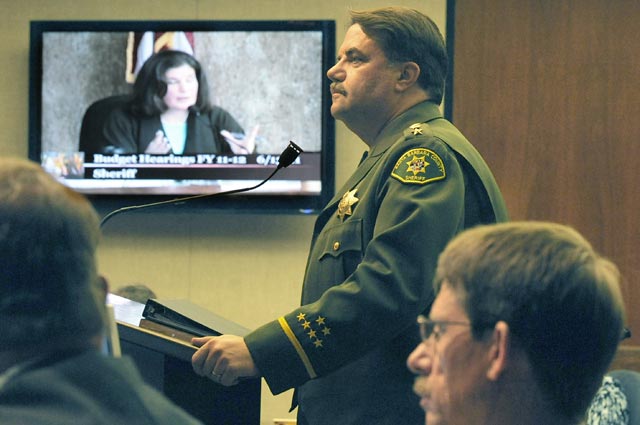Budget Hatchet Cleaves into Basic Services
Supervisors Wrestle with Largest Deficit Ever

There are only so many words that can be used to describe a budget like the one the Santa Barbara County Board of Supervisors is currently mulling over, with a $72-million gap they must figure out how to close. Most of that vocab has been exhausted over the past three years, years when the deficit was considered “bad”: In the 2008-2009 and 2009-2010 fiscal years, the board had to settle budget deficits of about $15 million; last year, the number jumped to $41 million.
This year, however, is by far the worst yet. As Sheriff Bill Brown told the Board of Supervisors Monday, summing up pretty much everyone’s feeling: “We’ll be doing less with less.”
Indeed, while public expectations of government remain high, the county’s ability to provide services will drop. The cuts could be as visible as the grounding of the fire department’s helicopter unit or as unseen as the recent closing of the county’s reprographics department, responsible for the printing and copying of the voluminous amounts of paper produced by all departments.
The county has tried everything, from furloughs to hiring freezes to deferrals, but the time has come to take bodies out of chairs. Much of the blame has been placed on the public employee — and rightfully so, to an extent.
Santa Barbara’s pension contributions have jumped from $37.6 million in 2004 to $104.2 million this upcoming fiscal year, including an increase of more than $15 million this year. The average employee in 2007 cost the county $91,400; this year, the average employee will cost $128,000. “The current salary and benefit levels are not sustainable now and won’t be in the future,” said CEO Chandra Wallar, in the midst of her first budget go-round in Santa Barbara.
Members of SEIU Local 620 — the largest union representing nearly 2,000 employees — received a 3.5-percent wage increase earlier this year and will later this month get another 2.5-percent boost along with a benefit allowance increase. Those hikes will cost $9.2 million this fiscal year. The Deputy Sheriffs’ Association received a 6-percent wage increase in February and will receive a 3-percent augmentation in August, a total of $4.5 million in costs to the county.
But to blame the grim fiscal realities all on the unions is not fair. They’ve also given up a lot over the last three years. The only reason they have seen many of the wage increases recently is because they had previously deferred them for months and years in an effort to save the county money, and the union jobs. They’ve also endured a hiring freeze and furloughs. “For several years we’ve given sacrifices,” said Bruce Corsaw, executive director of Local 620.
“The people that run toward the bullets, that answer 9-1-1 calls, that break up domestic-violence fights, but yet at budget time we’re the first people with the biggest target on our back.”
The unions are also quick to point out they aren’t a big group of fat cats getting rich off the county but are generally the janitors cleaning the bathrooms or the maintenance workers tidying the parks. “If you don’t have front-line staff to provide services, you don’t have government,” Corsaw said. In the case of the Deputy Sheriffs’ Association (DSA), they are the men and women responding to 9-1-1 calls at a time when violence against law enforcement officials is on the rise. In the county over the last year alone, there have been 33 assaults on personnel, Sheriff Brown said. Deputies are the “people who give every single day to a job that no one wants to do, and they’re the first people that get called to do it,” said DSA President Chris Corbett. “The people that run toward the bullets, that answer 9-1-1 calls, that break up domestic-violence fights, but yet at budget time we’re the first people with the biggest target on our back.”
Currently, the county is negotiating with several employee union groups, including SEIU, whose contract with the county expires at the end of the month. Concessions by labor groups could save Santa Barbara money. But until then, the county will be cutting positions — a lot of them. The county employed 4,193 people in 2004, a number that will drop this year to 3,683. Some of the spots are already open due to attrition. But many are not. The result will be the reduction or elimination of all non-core services, Wallar said, along with the scaling back of others. She said the county will not see a return to prior levels and is dealing with a new paradigm and new reality.
At Monday’s budget hearings, public safety took center stage. Always priority number one for government, public safety receives the greatest amount of funding. But cuts to the Fire Department, Probation Department, Sheriff’s Department, and District Attorney’s Office, combined with increased crime numbers and recent natural disaster scares, will have serious impacts. “Make no mistake about it: These cuts will result in diminished public safety in Santa Barbara County,” Brown said.

Tuesday afternoon, a day after arguing against cuts to her department in front of the Board of Supervisors, District Attorney Joyce Dudley was in Santa Barbara Superior Court, selecting a jury in an upcoming torture case. She was there because Paula Waldman, a senior prosecutor on the case, had just secured a guilty verdict in an attempted-child-molestation case in another courtroom and was attempting to prove to the jury it was the suspect’s third strike, which could put him behind bars for life. The case was one of eight trials the DA’s Office has been prosecuting in the last 30 days — four up north and four in the south — where the potential penalty was life in prison.
It served as a perfect example of the duress under which the DA’s Office is working. Attorneys in the DA’s Office have the highest caseload — an average of 418 cases apiece — of any in the state. In the last 10 years, according to Dudley, the county has seen a 1,422-percent increase in gang crime and 311-percent increase in murders and attempted murders. “Crime has grown and the office hasn’t,” said Chief Deputy DA Gordon Auchincloss.
“The DA budget being recommended to you by the CEO’s office will not be enough for me to fulfill my legally mandated responsibility,” Dudley told the supervisors Monday.
The office — which has seen several top-level attorneys with decades of experience retire over the past year — needs $1.2 million to keep its current prosecution team. “The DA budget being recommended to you by the CEO’s office will not be enough for me to fulfill my legally mandated responsibility,” Dudley told the supervisors Monday.
Frequently sitting at the defense counsel table across from a prosecutor is someone from the Public Defenders Office, which appeared in 23,000 cases over the last year, according to its head, Raimundo Montes de Oca. The county is constitutionally mandated to provide a legal defense to people who can’t afford one, but cuts have threatened to take that ability away. Each of the office’s 17 felony attorneys have in excess of 206 cases a year, while misdemeanor attorneys carry a caseload of more than 900. But numbers don’t define the office’s work, de Oca said. “We help restore our clients’ lives,” he said. His office supports the work of the treatment court, which gets people the help they need to fight addictions rather than throwing them in jail. But decreases in support staff make attorneys take on more administrative roles, and their ability to do their jobs is diminished. “We cannot afford any more cuts,” said Deedrea Edgar, deputy public defender.
Ominous clouds loom over the Sheriff’s Department, the county’s largest department, and the Probation Department, as well. The sheriff said cuts to his department (proposed at $8 million) would mean the elimination of the gang unit and heavy cuts to the high crimes and narcotics units, while response times would go up. The Santa Maria Jail is on the chopping block, as well, which would mean that a person arrested in the North County would have to be transferred all the way to the main facility in Goleta. This will result in either officers becoming taxi drivers for potential inmates or more cite-and-releases, even for crimes that wouldn’t normally be cite-and-release crimes.
Conversely, the Santa Barbara Booking Station, where kids from South County can be held before being transferred to the Juvenile Hall in North County, would be closed, meaning South Coast law enforcement would be in a similar pickle down here: to transfer, or to cite and release. The South County Juvenile Hall was originally made into a booking station after budget cuts in 2008.
The number of countywide juvenile probation officers could drop by 10 percent, while the number of adult probation officers could by 16 percent. Both of those groups have already seen reduced funding of roughly 30 percent since 2008.

County Fire, meanwhile, will see an 11.3-percent decrease in employees from two years ago. The department will lose three engineers, three firefighters, and defund the air operations program and fuels crew program should proposed cuts go through. In preliminary discussions, 2nd District Supervisor Janet Wolf suggested not grounding the air operations program — made up of two helicopters—until a more complete discussion is undertaken regarding the entire county air fleet (which also includes four Sheriff’s helicopters and a fixed-wing aircraft). Over the last few years, there has been much consternation between the two departments about the capabilities of each other’s air operations. A subcommittee of Wolf and 5th District Supervisor Steve Lavagnino has commenced on a quest to get solid answers.
The supervisors heard the plight of public safety officials loud and clear Monday and were sympathetic to the situation. But while the outlook was grim, Monday frighteningly, was just the beginning. In the budget discussions that followed, the board heard about cuts to programs in other departments, many of them serving the county’s most vulnerable populations: a reduction in funding that will result in 110 fewer children receiving health insurance through a program for thousands of county kids who aren’t covered by state programs, a reduction in hours at county library branches, and the elimination of the Human Services Commission ($1.2 million in funding that is handed out to nonprofits every year). Proposed cuts to Alcohol, Drug and Mental Health Services means increased caseloads for child clinicians, the loss of community treatment for those with mental illness, and the reduction of services to those with substance-abuse issues.
This also does not take into account whatever trickle-down effect — which inevitably will be a negative one — might come from the passage of a state budget. The Legislature has a constitutional mandate to pass a budget by June 15, but as of our deadline Wednesday morning, that had not yet occurred.
Meanwhile, the supervisors were scheduled to begin deliberating Wednesday and to finish up Friday. They’ve opened up time next week, as well, if they need to tie up loose ends.



